
Quick Summary: The modern PMO definition has shifted from a support function to a strategic engine that brings discipline, clarity, and data-driven foresight to organizational execution. As projects become increasingly complex, the PMO becomes essential for aligning initiatives with business goals, strengthening accountability, and enabling smarter, faster decisions, particularly with the rise of AI-powered insights. This article breaks down what a PMO truly is, why it matters, and how it can become a catalyst for measurable impact rather than a center of routine oversight.
How the Modern PMO Definition Is Reshaping Execution, Efficiency, and Enterprise Growth
Over time, the concept of a project management office (PMO) has evolved from being a niche function in large corporations to a critical asset for businesses of all sizes. What was once a familiar term only in multinational firms is now making its way into small and medium-sized enterprises, helping them bring structure, efficiency, and clarity to project execution.
This shift is evident in the growing adoption of PMOs across industries. PMOs have gained significant traction over the last decade, steadily increasing their presence in organizations. According to the State of Project Management Survey 2020 (UK: Wellingtone PPM), more companies are recognizing the value of a PMO in driving efficiency and business success. Moreover, the integration of artificial intelligence-driven project management solutions has further amplified this impact, enabling PMOs to leverage data-driven insights, automate repetitive tasks, and enhance decision-making processes. These advancements improve project outcomes and allow PMOs to concentrate on strategic initiatives and innovation.
But what exactly is the definition of PMO, and why does it matter? A well-established PMO streamlines project management processes, ensuring alignment with business objectives and enhancing overall project delivery. It plays a crucial role in standardizing practices, optimizing resources, and fostering a culture of accountability.
This article explores the importance of PMO, its key responsibilities, and its direct impact on project success. Let’s start with the basics—what exactly is a PMO?

What Is the Meaning of PMO?
A project management office (PMO) is the organizational unit that brings structure, discipline, and consistency to how projects are planned, managed, and delivered. It defines and maintains the standards that guide project teams, improves the way work flows across departments, and supports leaders with the information they need to make confident decisions.
PMOs come in different forms, each with a distinct purpose:
- Project Management Office: Focuses on supporting project teams, maintaining documentation, refining processes, and ensuring projects follow well-defined practices.
- Program Management Office: Coordinates multiple related projects, oversees program governance, and ensures teams stay aligned with broader outcomes.
- Portfolio Management Office: Looks at the organization’s complete set of projects and programs, ensuring investments support strategic goals and helping leadership prioritize what matters most.
Today, PMOs are nearly universal. According to the State of Project Management Report 2025: Wellingtone PPM, 82% of organizations now operate one or more PMOs, reflecting how essential they’ve become to business performance.
A strong PMO becomes the central source of truth for project activity, collecting data, monitoring progress, surfacing risks, and guiding leaders toward timely, strategic choices. By connecting projects with organizational objectives, the PMO helps companies protect their investments and ensure every initiative delivers measurable value to stakeholders.
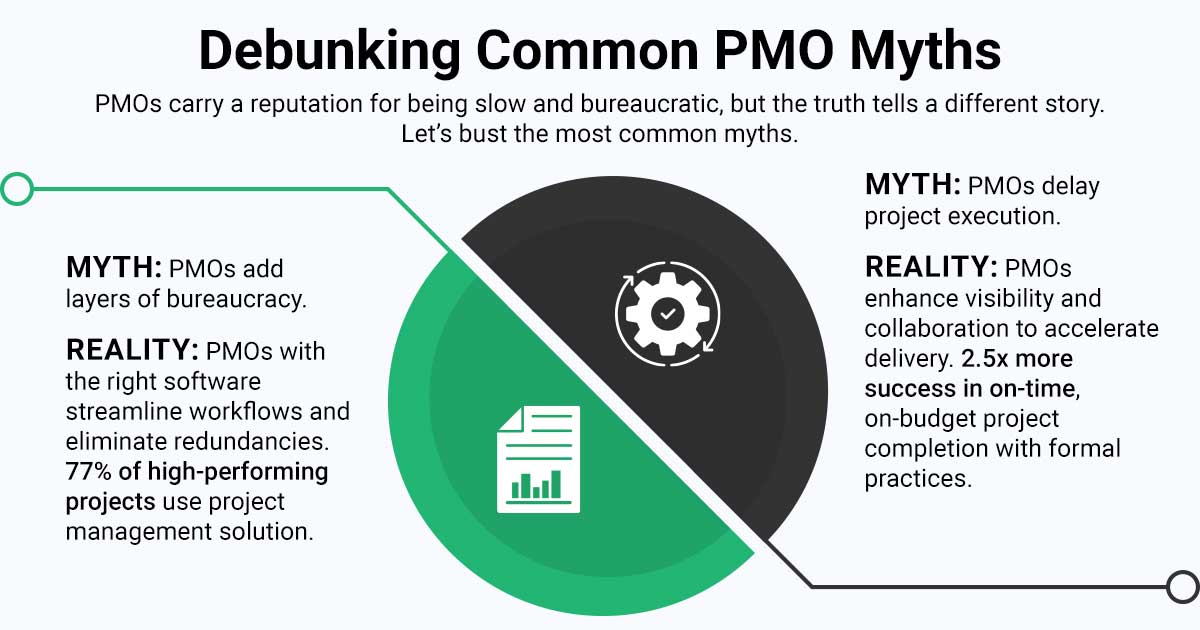
Many PMOs also assume portfolio-level responsibilities, providing continuous oversight of active projects so that leadership can understand performance, identify early warning signals, and steer the business toward better outcomes. With the support of modern PMO software, they convert scattered information into clear insights, streamline coordination across teams, and strengthen accountability.
When operating effectively, a PMO brings consistency across projects, reduces operational waste, and enables teams to work with clarity and purpose. Ultimately, a PMO helps organizations execute the right projects in the right way and create meaningful impact through disciplined, insight-driven project delivery.
If a PMO is this pivotal to shaping outcomes, the next question becomes simple: What exactly does it do behind the scenes to keep an organization moving in the right direction?
Are you curious to see how an AI-powered PMO could transform your organization? Request a demo today and discover how our solution can help you predict risks, optimize resources, and deliver projects with greater confidence and precision.

PMO Functions: What Does a PMO Do?
A project management office serves as the organization’s central control center for planning, managing, and delivering projects. Its purpose is simple: strengthen consistency, protect performance, and help teams work with clarity. Whether built in-house or provided as an external service, a PMO performs several essential functions that significantly impact the success of projects.
1. Strategic Alignment and Governance: A PMO evaluates which projects deserve investment, ensures they support business priorities, and guides leadership with clear cost–benefit insights. Utilizing an AI-driven project management solution analyzes historical performance, risk patterns, and business priorities to recommend which projects will create the most substantial impact. It provides structure, allowing decisions to be made with intention rather than impulse.
2. Defining the Right Delivery Approach: It sets the project management methodology that the organization will adopt. Whether teams use waterfall, agile, or a hybrid model, the PMO outlines how work should flow and ensures everyone follows the same playbook.
3. Establishing Best Practices: The PMO standardizes processes, templates, and documentation. It establishes a consistent set of practices that every department can rely on, reducing inconsistency and saving time throughout the organization.
4. Strengthening Organizational Project Culture: It assesses the maturity of project management within the company and improves it through training, communication, and shared guidance. This helps teams operate with a unified mindset, rather than adopting isolated approaches.
5. Resource Planning and Allocation: A PMO ensures people, budgets, and tools are assigned where they create the most impact. It balances workloads, identifies capacity gaps, and helps teams avoid delays caused by resource conflicts.
6. Building Project Tools and Archives: It develops repositories of templates, best practices, and project documentation. These resources enable teams to get started more quickly and minimize repetitive work.
7. Ensuring Governance and Accountability: The PMO verifies that the appropriate leaders make key decisions and that the information they rely on is accurate. Incorporating a predictive project management solution into your existing task management systems enables you to identify inconsistencies, detect project risks early, and verify whether teams adhere to established processes, ensuring accountability remains strong.
8. Improving Transparency Across Projects: It provides reliable, real-time information that supports smart decision-making. Leaders gain visibility into progress, risks, and performance without having to chase scattered data.
9. Enabling Reusability and Continuous Learning: Instead of starting from scratch, teams can draw from lessons learned, reusable templates, and proven practices. This builds momentum by reinforcing what already works.
10. Supporting Project Teams: The PMO trains, mentors, and guides project teams. It reduces unnecessary bureaucracy, improves quality assurance, and ensures teams can focus on delivering outcomes rather than getting stuck in process challenges.
11. Maintaining Traceability and Documentation: It organizes project histories, decisions, and knowledge assets. This ensures continuity, especially during handovers or leadership transitions.
With its functions clearly established, it’s time to examine the specific roles and responsibilities that enable a PMO to transform structure into meaningful execution.
Want to strengthen your PMO with predictive analytics and actionable insights for better project outcomes? Contact us today to learn more about how TrueProject can help you achieve project success with data-driven precision.
What Are the Key Roles in a PMO and Their Core Responsibilities?
Organizations managing several cross-functional projects cannot depend on scattered systems or informal coordination. With the right mix of people, processes, and tools, it becomes the driving force behind efficient execution. Here are some key PMO responsibilities:
- Select the Right Projects: The PMO reviews proposed initiatives, prioritizes the ones that support organizational goals, and defines the policies and workflows that guide project selection and oversight.
- Champion Strong Project Management Practices: It aligns teams through communication, training, and shared methodologies. With consistent techniques and clear KPIs, the PMO builds a unified project culture.
- Perform Effective Resource Management: The PMO defines responsibilities, manages priorities, and allocates talent based on timelines and budgets. This reduces internal friction, allowing work to progress smoothly.
- Mobilize Project Tools and Systems: It maintains the templates, software, and work management tools that centralize project data. This enhances reporting, deepens insights, and reduces reliance on fragmented methods.
With the PMO’s responsibilities established, the next step is understanding the people behind them, the specialists who shape, guide, and strengthen project execution.
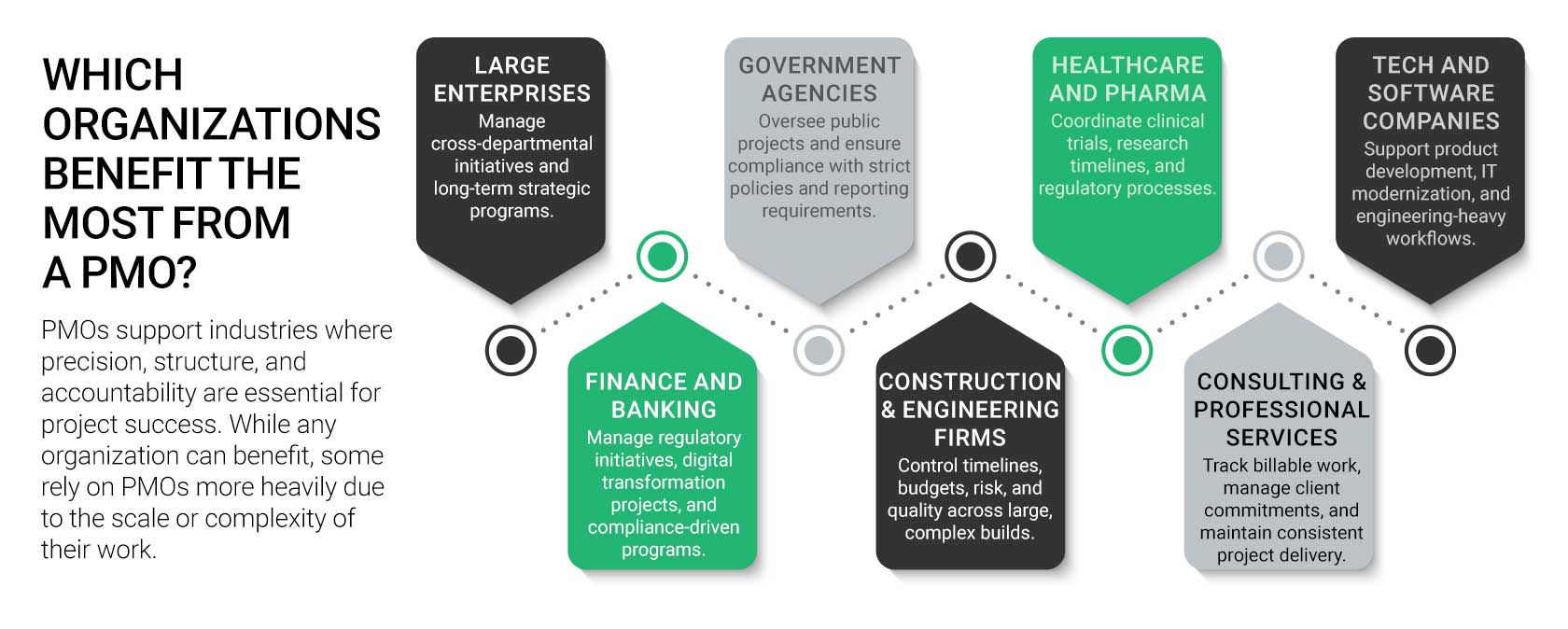
Who Typically Works Inside a PMO?
A project management office brings together a diverse team of specialists who guide, oversee, and support the execution of projects across the organization. Each role contributes a different layer of control, clarity, and decision support.
- Project Managers: They develop detailed project plans, lead execution, track milestones, manage risks, and serve as the primary point of contact for stakeholders to ensure work remains aligned with expectations.
- Program Managers: They oversee groups of related projects, define program goals and benefits, and ensure every project contributes to broader organizational outcomes.
- Portfolio Managers: They prioritize projects and programs based on strategic value. By monitoring KPIs and resource use across the portfolio, they reduce conflicts and identify high-level risks early.
- PMO Manager: They oversee the entire PMO, manage team performance, guide the project intake process, improve processes, review financials, and ensure the PMO consistently delivers measurable value.
- Business Analysts: They capture and interpret business requirements, collaborate with stakeholders, and create clear documentation that guides accurate project execution.
- Financial Analysts: They assess project costs, budgets, economic risks, and performance. Their insights enable leaders to make informed decisions and maintain financial discipline across all initiatives.
- Risk and Compliance Officers: They ensure adherence to organizational policies, identify potential risks, develop mitigation plans, and continuously monitor threats to keep projects on track.
Every role inside the PMO contributes to stronger execution and smarter oversight. But what does this translate to in terms of real, measurable benefits?
What Are the Benefits of PMO?
A project management office (PMO) becomes essential when an organization reaches a point where juggling multiple projects starts to feel chaotic. When teams struggle to prioritize resources, standardize processes, or manage risks efficiently, a PMO brings order, structure, and visibility across the entire portfolio. Here’s how:
- Brings Clarity Across the Organization: Scattered spreadsheets slow decisions and create silos. A traditional PMO improves coordination, but manual work limits visibility. An AI-driven PMO centralizes real-time insights, predicts risks early, optimizes resources, and provides stakeholders with instant clarity for faster, data-driven decisions.
- Cuts Down Project Resourcing Costs: By anticipating resource needs and assigning the right talent at the right time, a PMO prevents delays, avoids unnecessary spending, and strengthens on-time delivery.
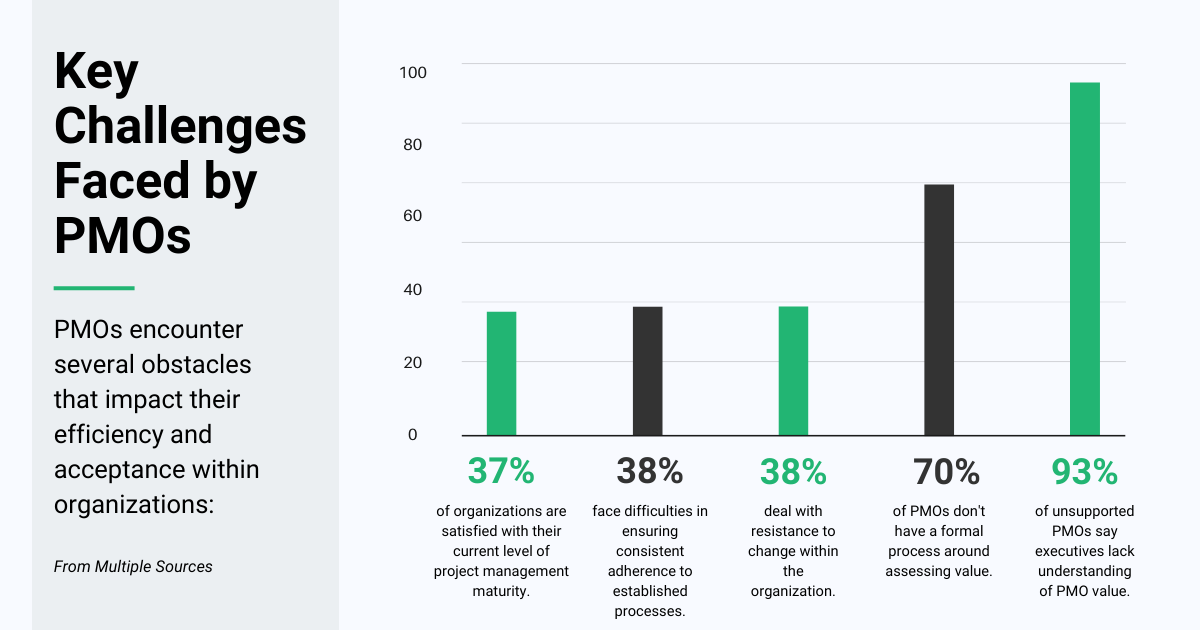
- Optimizes Resource Utilization: A PMO tracks availability, forecasts demand, and allocates talent wisely. Shifting workloads between billable, non-billable, and strategic tasks helps prevent burnout and maintains high efficiency.
- Supports Smarter Business Decisions: A standard PMO streamlines processes and monitors KPIs. A predictive intelligence-powered PMO provides real-time insights, proactive risk alerts, and forward-looking visibility, enabling organizations to act before disruptions occur.
PMO is about creating a system where projects run smoothly, resources are used wisely, and the business is always ready for what’s next.
Given these benefits, how do you know if your business needs a PMO?
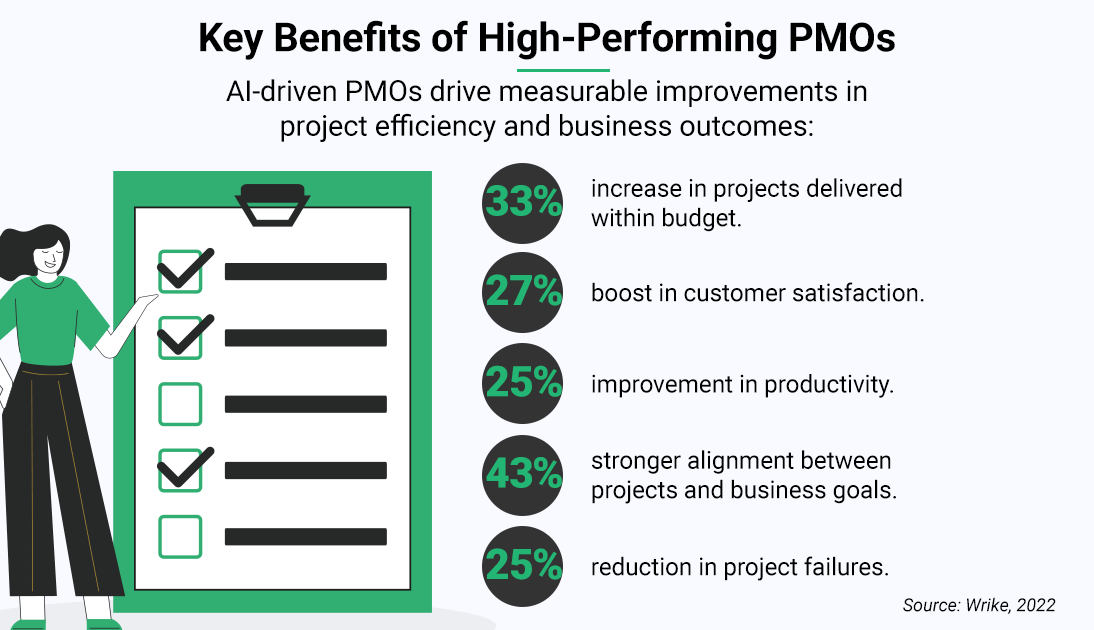
Alt Text: Infographic showing key PMO benefits including higher budget compliance, customer satisfaction, productivity, alignment, and reduced failures.
Does Your Business Need a PMO?
Not every organization has a project management office (PMO), and not all need one. However, as the number of projects increases, so do the challenges, such as missed deadlines, strained resources, and conflicting priorities, which can make it more difficult to deliver results. That’s where a PMO steps in.
PMO ensures that every project syncs with your business’s broader strategy. It helps allocate resources efficiently, reducing the chances of failure and keeping teams focused on what matters most.
If you’re asking, “How do I know if I need a PMO?”, here are the most common signs:
- Projects consistently miss deadlines or run over budget.
- There’s a disconnect between projects and business objectives.
- Stakeholders struggle to get a clear view of project progress.
- There’s no standardized approach to starting and managing projects.
- Measuring project success feels like guesswork rather than a data-driven process.
If any of these challenges sound familiar, consider a PMO. It’s not just about structure; it’s about ensuring every project moves the business forward. Transitioning to a PMO role can be a rewarding opportunity for project managers seeking to advance their careers.
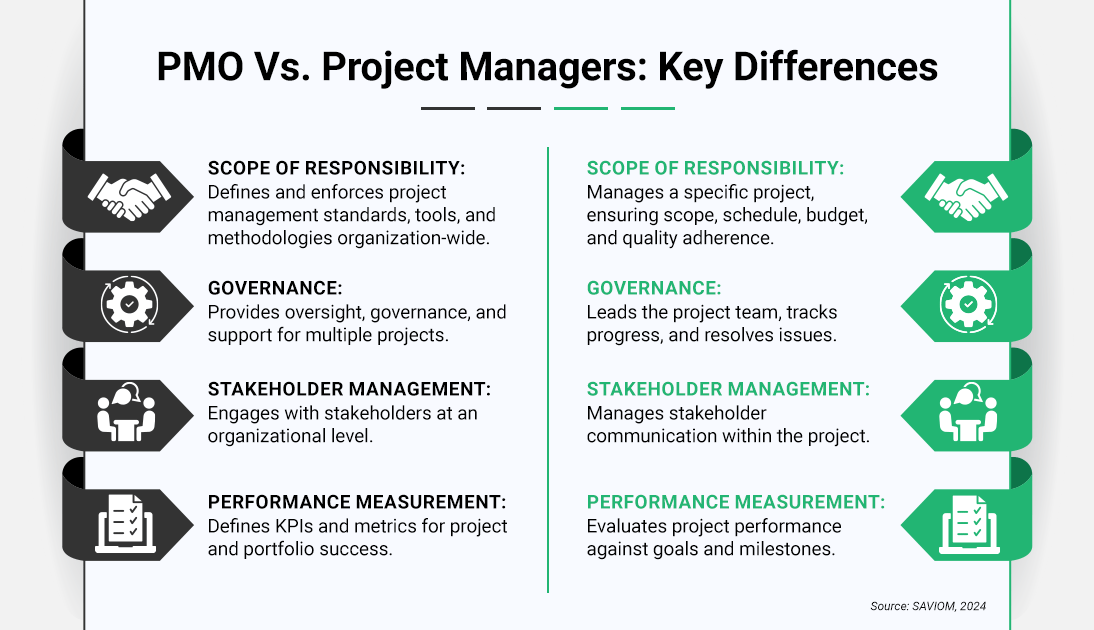
From Project Manager to PMO Leader: How to Elevate Your Career
Are you a project manager considering a transition into a PMO role? It’s more than governance—it’s about driving real strategic value. The best PMOs shape culture, leverage technology, and elevate project managers into strategic leaders. Some even sit at the executive table, ensuring projects align with business goals.
A PMO role might be the next step if you want to expand your impact. Here’s how to get there:
- Get involved: Connect with PMO leaders in your company. Let them know you’re interested and look for ways to contribute.
- Sharpen your skills: Take on responsibilities that align with PMO functions. Internal development programs can help.
- Step up: Volunteer for PMO-led initiatives to gain direct experience.
- Certify your expertise: Stand out with credentials like PMO-CP™, PMP®, or PgMP®.
Transitioning from project management to a PMO role takes continuous learning, strong leadership, and strategic thinking. Stay ahead of industry trends and refine technical and soft skills to make your move. However, stepping into a PMO role isn’t just about overseeing projects, but also about driving meaningful business outcomes. To ensure your PMO is driving real impact, focusing on strategic value creation is essential. This begins with understanding how to leverage data, foster collaboration, and align project outcomes with overarching business objectives. Let’s explore how you can elevate your PMO’s role from governance to becoming a catalyst for organizational growth and success.
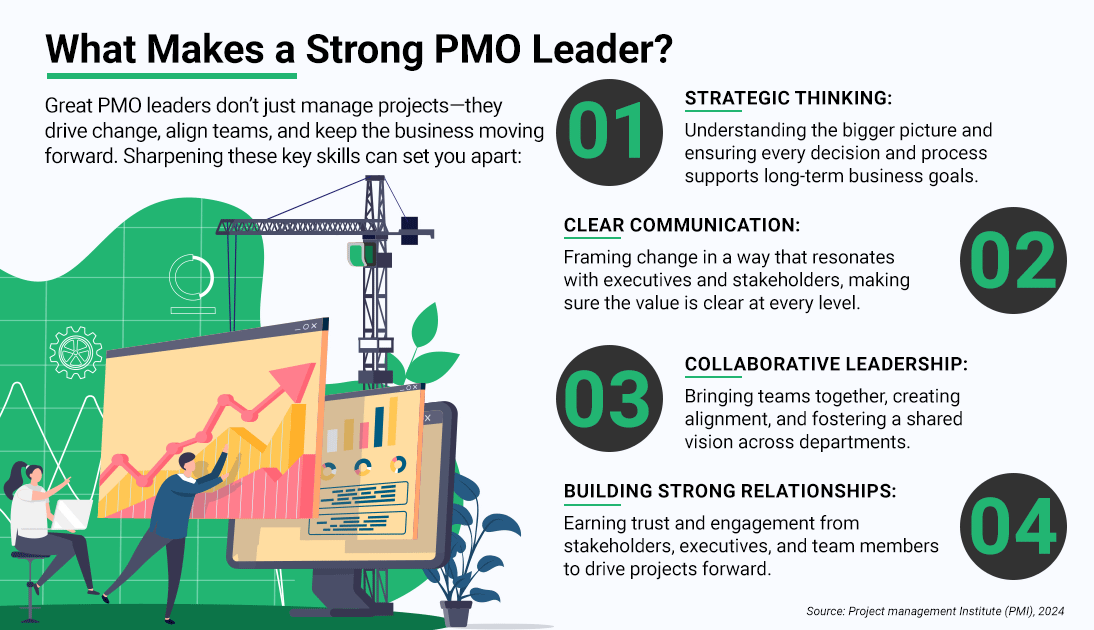
Is Your PMO Driving Real Impact or Just Tracking Projects?
A Project Management Office (PMO) is a necessity for organizations aiming to achieve consistent project success and strategic alignment. By standardizing processes, optimizing resources, and providing real-time insights, a PMO ensures projects deliver tangible value while staying aligned with business goals. Whether your organization is scaling rapidly or managing complex portfolios, a PMO brings structure, clarity, and efficiency to project execution. For project managers aspiring to lead, transitioning into a PMO role offers an opportunity to drive strategic impact and shape organizational success. But how do you take it beyond governance and reporting? What if you could make data-driven decisions that prevent costly mistakes?
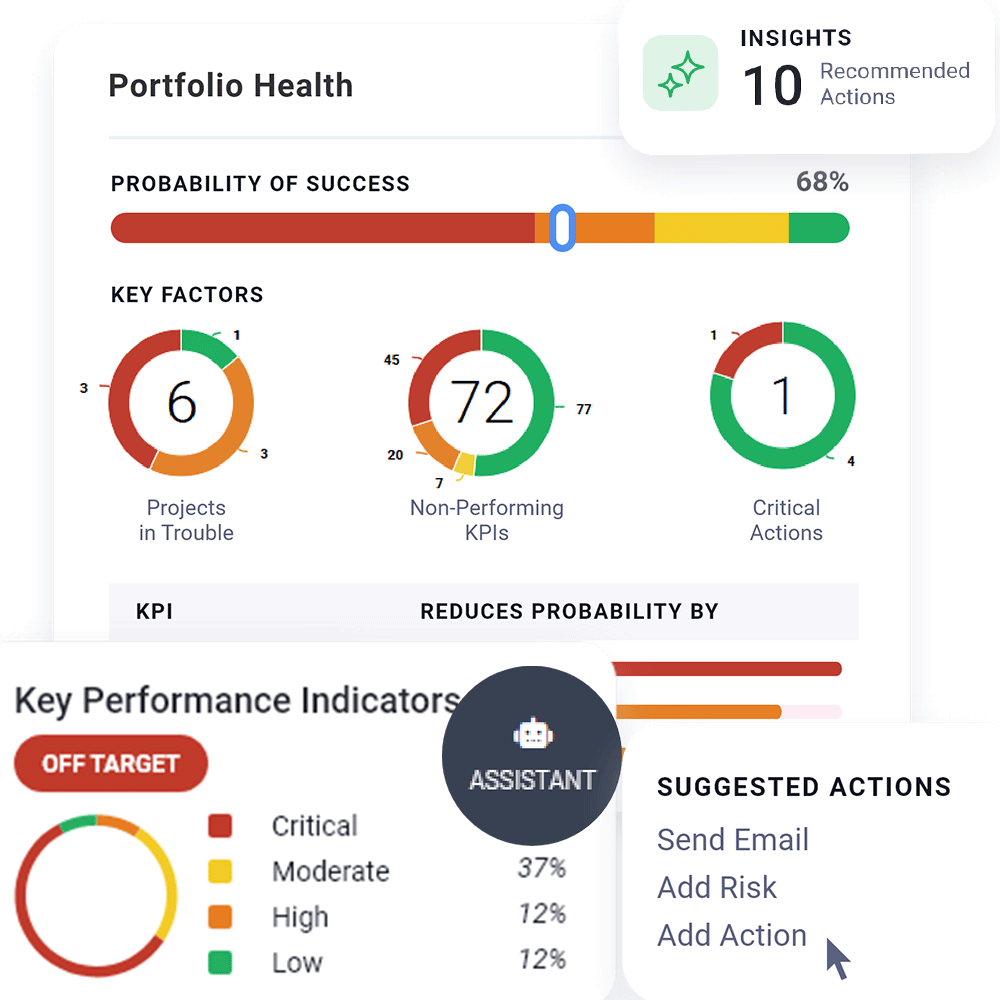
Predictive intelligence-driven PMOs transform project management by offering predictive insights, automating repetitive tasks, and enabling data-driven decision-making. In project-driven organizations, this ensures faster adaptability, reduced risks, and improved outcomes. TrueProject is a KPI-based predictive project management SaaS solution that enhances project health and performance, revolutionizing project management by predicting potential issues before they escalate, thereby ensuring consistent success. By integrating real-time data, stakeholder feedback, and industry best practices, TrueProject offers a comprehensive 360-degree view of project health, enabling proactive decision-making and fostering seamless team collaboration. Its customizable dashboards and flexible monitoring tools provide clarity and control, allowing you to focus on high-impact tasks and mitigate risks effectively. With TrueProject, uncertainties are eliminated, operational costs are reduced, and productivity is enhanced—transforming project challenges into opportunities for success.
Don’t just manage projects, control outcomes, eliminate uncertainty, and turn every initiative into a strategic advantage.
See the hidden risks holding your projects back. Get your free TrueProject Snapshot and experience predictive intelligence in action.
Frequently Asked Questions (FAQs) About PMO
Q1: What is the simple definition of a PMO?
A Project Management Office (PMO) is a central department within an organization that defines and maintains standards for project management. It provides guidance, processes, and tools to ensure projects are completed successfully and align with business goals.
Q2: What are the 3 types of PMOs?
The three common types are:
- Supportive PMO: Provides templates and best practices but has low control.
- Controlling PMO: Enforces standards and methodologies across projects.
- Directive PMO: Actively manages and directs projects by providing project managers with high-level control.
Q3: What is the difference between a project manager and a PMO?
A project manager is an individual responsible for leading a single project to completion. A PMO is an organizational entity that oversees all projects, standardizes processes, and supports all project managers within the organization.
Q4: What is the primary goal of a PMO?
The primary goal of a PMO is to improve project success rates by standardizing processes, ensuring strategic alignment, optimizing resource use, and providing centralized oversight and reporting.
Q5: How does an AI-powered PMO differ from a traditional one?
A traditional PMO focuses on tracking and reporting past performance. An AI-powered PMO, supported by a platform like TrueProject, uses predictive analytics to forecast risks, identify trends, and provide proactive recommendations, shifting the focus from reactive problem-solving to proactive value creation.






